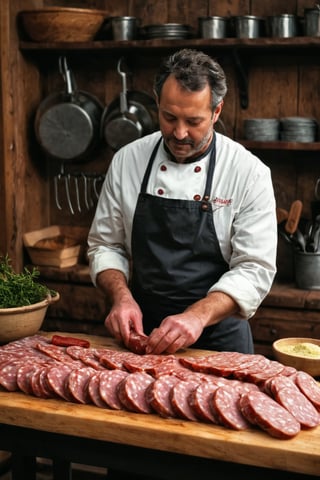LaRecalcada
Published:
Create a richly detailed and captivating illustration depicting the traditional process of making Italian salami. The scene should flow from left to right, capturing each stage in a rustic, artisanal setting with a warm, old-world Italian charm: 1. **Selection and Preparation:** Begin with a scene of an Italian butcher carefully selecting and preparing high-quality cuts of pork. Show the butcher trimming and cutting the meat on a wooden butcher block, surrounded by ingredients like fresh herbs, garlic, and spices. Include an Italian countryside in the background. 2. **Grinding and Mixing:** Illustrate the meat being ground through a traditional hand-cranked meat grinder. Next to it, depict a large mixing bowl where the ground meat is combined with salt, pepper, fennel seeds, and other spices. A worker is mixing the meat with their hands, ensuring even distribution of flavors. 3. **Stuffing:** Show the seasoned meat being stuffed into natural casings. Use an old-fashioned sausage stuffer, with one person cranking the machine and another guiding the casing to fill evenly. Highlight the smooth, consistent filling process with plump, neatly filled salami links. 4. **Tying and Hanging:** Visualize the salami being carefully tied with butcher’s twine into uniform links and then hung on wooden racks for curing. Depict a cool, dimly lit curing room with rows of salami hanging from the ceiling, the atmosphere rich with the aroma of curing meats. 5. **Curing and Fermentation:** Portray the salami undergoing the curing process. Show the gradual transformation as the salami ages, drying and developing its unique flavors and textures. Include a detailed view of the white mold that forms on the casing, essential for flavor development and preservation. 6. **Aging:** Transition to a storage room where the salami hangs to age further, deepening in flavor. Highlight the rustic, wooden beams and shelves filled with neatly hung salami. Include details like the darkened, cured exterior and the shrinkage of the meat as it loses moisture over time. 7. **Slicing and Serving:** Conclude with a vibrant scene of the final product being sliced and served. A chef is slicing the cured salami on a wooden cutting board, arranging thin, marbled slices on a platter. Surround the scene with complementary items like crusty bread, olives, and a glass of red wine. Use warm, inviting lighting and detailed textures to bring the process to life, from the fresh herbs and spices to the rich, marbled meat of the final product. Each stage should be clearly labeled to guide the viewer through the artisanal craft of making Italian salami. This prompt should create a vivid and engaging depiction of the traditional process of making Italian salami, highlighting the craftsmanship and rustic charm.
Comments




